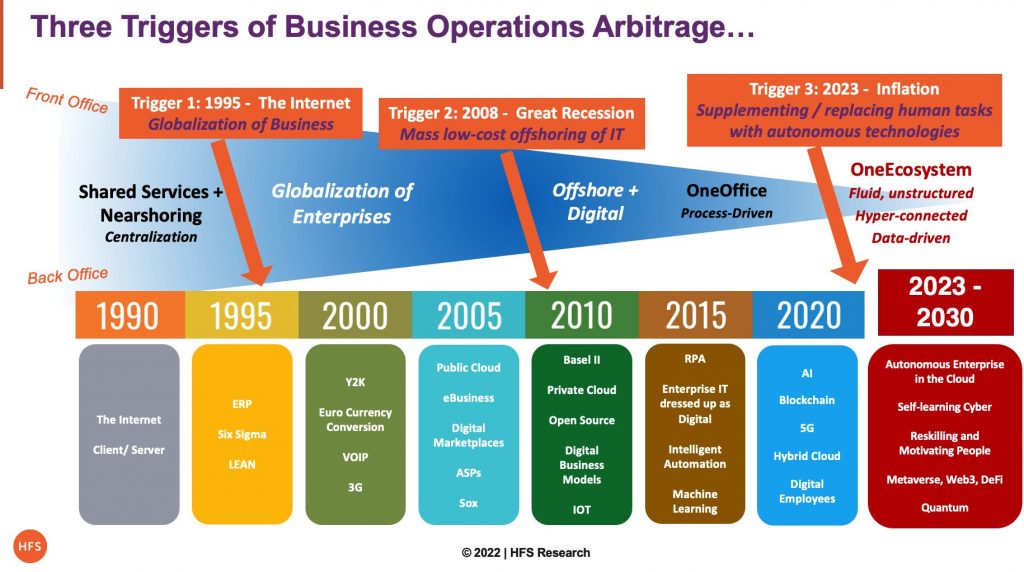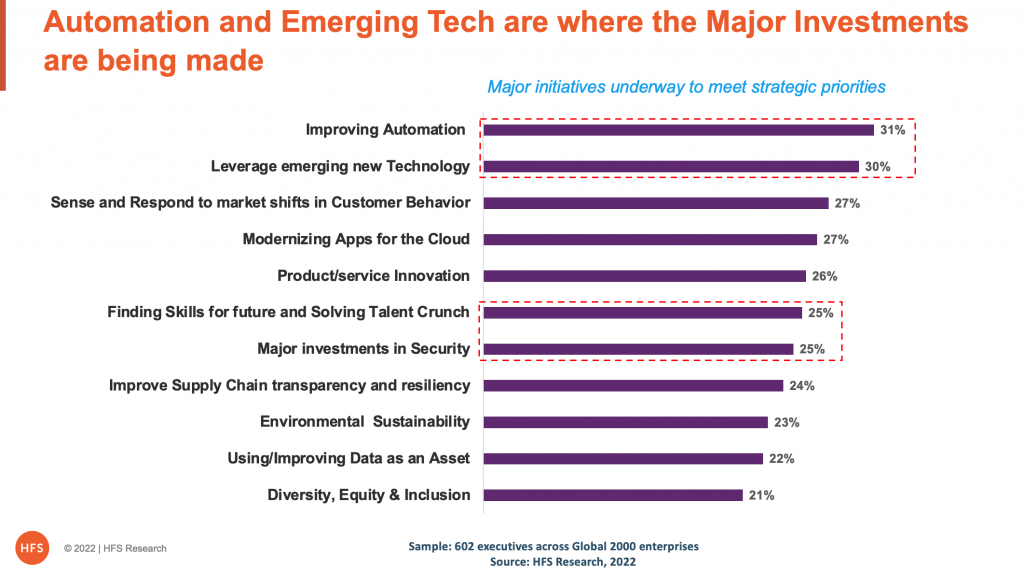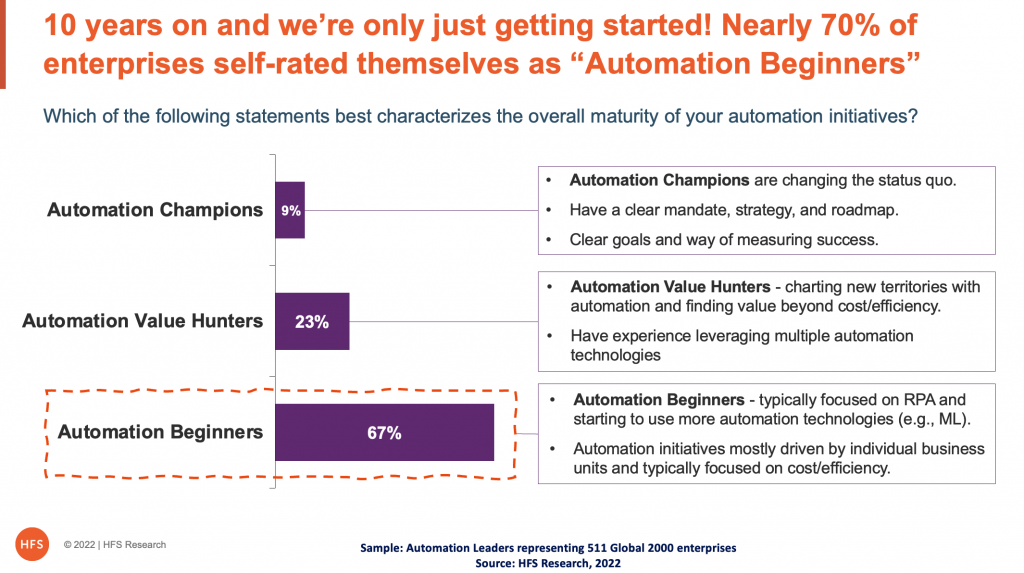Nothing dictates real secular change to enterprise operations than financial pressures, and we are rapidly arriving at a third major trigger that will lead to the evolution of many autonomous enterprises where leaders have no choice but to drag their operations out of the dark ages:

Trigger 1: 1995 – The Internet drives globalization. The advent of the Internet at the turn of the millennium drove the first major wave of globalization of business and operations.
Trigger 2: 2008 The Great Recession brings about mass low-cost offshoring of IT. In 2008… the Great Recession drove a 15-year wave of tremendous offshoring growth… based on lower-cost labor to slash costs.
Trigger 3: 2023 Inflation drives organizations to supplement or replace human labor with autonomous technologies. In 2023… wage inflation, recession, and people refusing to return to the office will drive a considerable wave of autonomous enterprises… based on technology to perform the tasks of humans to stay afloat.
What is an “Autonomous Enterprise”?
An autonomous enterprise is one whose leadership continuously seeks to refine the data it needs in real-time to be successful. Its governance capability ensures it has the talent, tech infrastructure, automation, and AI to deliver the data that will drive success with minimal manual interventions that impede progress and speed. The ultimate goal of an autonomous enterprise allows us humans to remove ourselves from some parts of the system so that we can make continuous improvements to the ecosystem as a whole.
Ultimately, this is about machines making decisions where we previously had humans and removing humans from loops that don’t need humans anymore. Leadership must understand the data they need to be successful and assemble and govern the right system to deliver success (see our Six Principles of the Autonomous Enterprise).
We are on the verge of the third significant trigger of business operations arbitrage – autonomous technologies at speed and scale
The advent of the Internet at the turn of the millennium drove the first significant wave of globalization of business and operations. Still, it wasn’t until the Great Recession of 2008 that sparked the first massive wave of IT offshore outsourcing saw the likes of Infosys, Cognizant, Wipro, and TCS enjoy enormous growth to become the multi-billion dollar firms they are today.
During the last decade, we have flirted with the advent of automation, where the rudimentary screen scraping, process, and system patches of RPA sparked the dreams of many CFOs and investors to “Automate the Enterprise.” The reality was that real progress with automation was never going to happen, while business unit leaders refused to make fundamental changes to their underlying processes and data. Plus, the fact that the global economy has been on a constant upward growth curve in recent years, and no one really drives painful, transformative change until economics forces them to.
Inflation-driven pressures will likely culminate in a huge wave of job reductions, sparking the demand for autonomous technologies to fill the void
In so many recent HFS roundtable conversations with enterprise leaders, there is one constant topic dominating proceedings: how to keep businesses functioning effectively when most staff are not willing to come to the office, when it’s impossible to coordinate complex process and workflow changes to the business, all while there is huge pressure to reduce inefficiencies, drive down costs and improve the quality of data.
In short, many businesses are limping out of the pandemic confusion, still struggling to pull themselves together, and in many cases, are slipping backward in terms of cementing their digital foundations and joining up key workflows across front-to-back offices.
Many organizations face significant staff reductions and have to figure out how to deliver on their operations and achieve their business outcomes with fewer people.
Operations leaders who cannot deliver on automation will become obsolete – it is now an expectation. Losing people will force smart managers to rethink how they can achieve more with less – you’ll simply have zero choice but to act. You’re running a finance department of 500 people, which is reduced to 250. How do you get stuff done now? You’d better reconfigure how processes work so you can take advantage of automation that can interact – via voice and digital – with self-learning capabilities that don’t need constant human supervision.
On the flip side, less people will make it easier to identify areas that demand urgent changes, and as they identify the critical data they need to be effective: do they know what their customers’ needs are? Is their supply chain effective in sensing and responding to these needs? Can their cash flow support immediate critical investments? Do they have a handle on your employee morale and performance?
Where technology can deliver routine tasks via simple automation and self-learning AI is becoming critical. HFS is using the team “digital employees” to describe how smart bots can function autonomously, can respond to both voice and digital interactions, can develop both short and long-term memories, can genuinely replace or supplement human activities to deliver workflows and processes that can provide the data company leaders need – at speed and at scale.
Automation is the leading tech investment being made among Global 2000 enterprises
10 years since HFS introduced RPA to the industry (see link), and we’re finally focusing on automation as a value-lever that drives business outcomes, as opposed to mere cost takeout in the back office.
The pandemic has shifted the automation focus from creating efficiencies in the back office to delivering immediate business impact, where talent shortages can be overcome, where digital workflows can operate despite broken supply chains, and where businesses can find new opportunities in their virtual and hyperconnected ecosystems.
Our recent pulse data of 602 enterprises proves beyond doubt that automation is the number one initiative currently underway to support enterprises in meeting their strategic priorities:

Automation is a discipline and a mindset
Automation is becoming so increasingly important to businesses as it helps solve so many of these endemic problems being caused by labor shortages, wage inflation, and poorly integrated systems, workflows, and processes. Simply put, if you get better at automating, you’re solving a lot of these other problems at the same time.
Smart business leaders have realized that automation is a mindset and a discipline that needs to be ingrained into every business practice. It is not why we do things; it’s how we do them. Automation makes what we have function effectively without needing constant human attention and manual workarounds. And the better we understand automation, the more autonomous it can become to drive genuine artificial intelligence interactions and processes in the future. AI and automation are becoming increasingly synonymous as we figure out how automation can really work within a business operation.
If there’s one thing the pandemic taught us, it’s been the necessity to re-think processes to get the data; what should be added, eliminated, and simplified across our workflows to source this critical data. And there is simply no option but to plan to design processes in the cloud using web-architected applications. In this virtual economy, our global talent must come together to create a borderless, completely digital business ecosystem where we can connect with other organizations that share common goals and purposes. This is the true environment for real “digital transformation” in action.
The Bottom-line: Most enterprises are only at the start of the real autonomous journey

As we reflect on our research covering over 500 automation leaders of major enterprises, what hits us the most is that 70% admit they are still novices. It seems the more they learn, the more they realize they need to know. We’re only at the start of a long journey for the majority of today’s ambitious organizations, and selecting the right partners along the way to help them design, implement and learn from automations across their businesses is so important. As one CIO delightedly pointed out to me recently: “I’ll keep finding automation ’till I die”… now that’s the attitude that is changing the whole approach to automation as the new IT mindset.
There is major rethinking taking place for 2023, where many firms are simply struggling to navigate this current maze of complexity and cost. The Autonomous Enterprise vision is where the survivors are looking, but getting there requires fewer people, politics, resistance to change, and great partnerships…
Posted in : Analytics and Big Data, Artificial Intelligence, Automation, Business Data Services, Business Process Outsourcing (BPO), Cloud Computing, Customer Experience, Data Science, Design Thinking, Digital OneOffice, Digital Transformation, Employee Experience, Finance and Accounting, Global Business Services, IT Outsourcing / IT Services, Metaverse, OneOffice, Process Discovery, Process Mining, Robotic Process Automation






